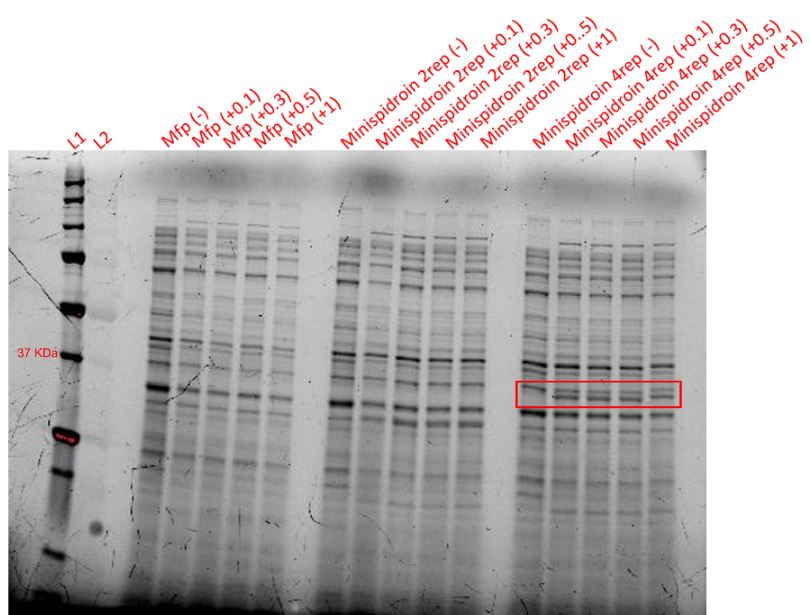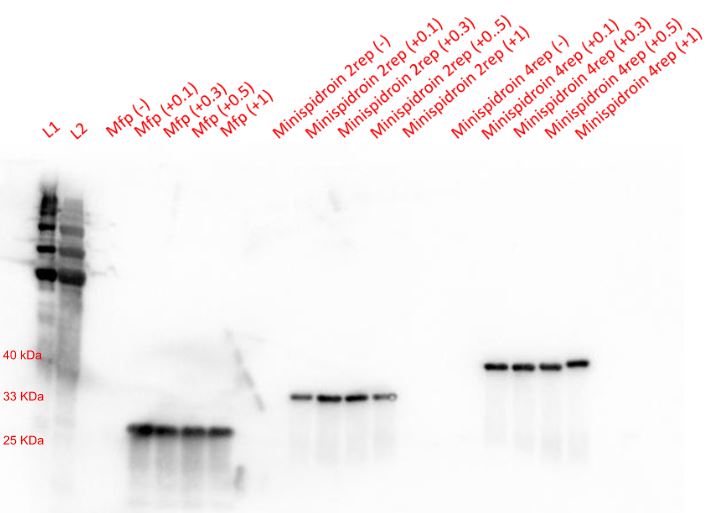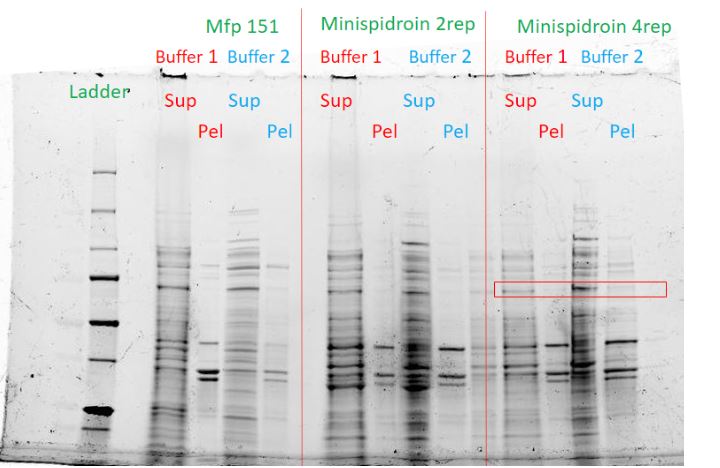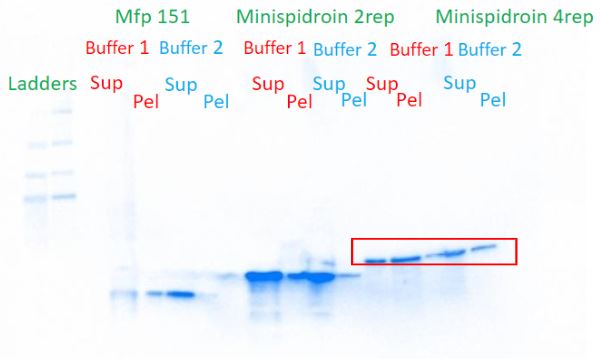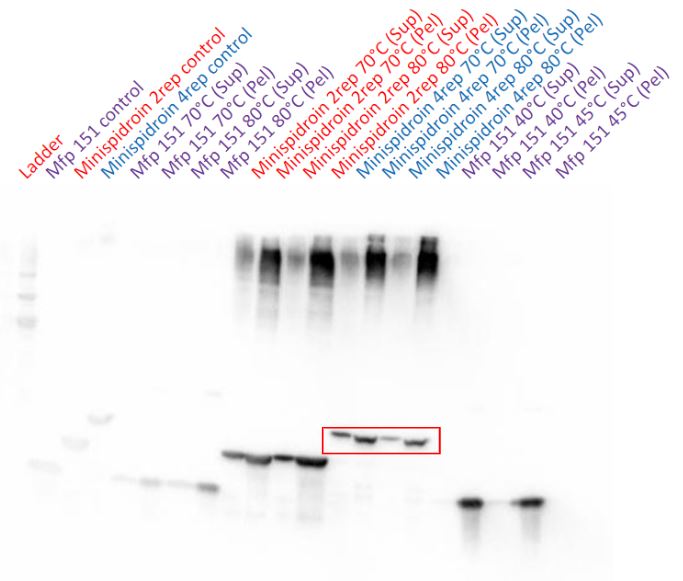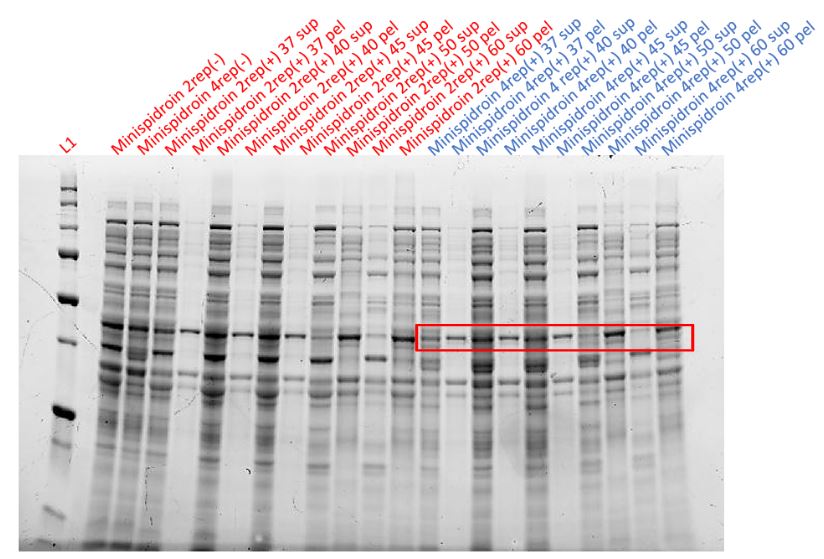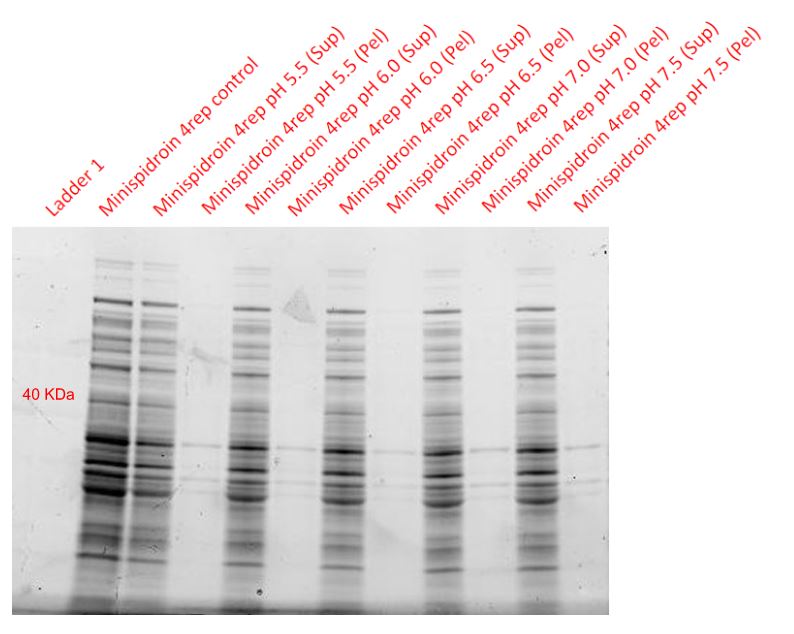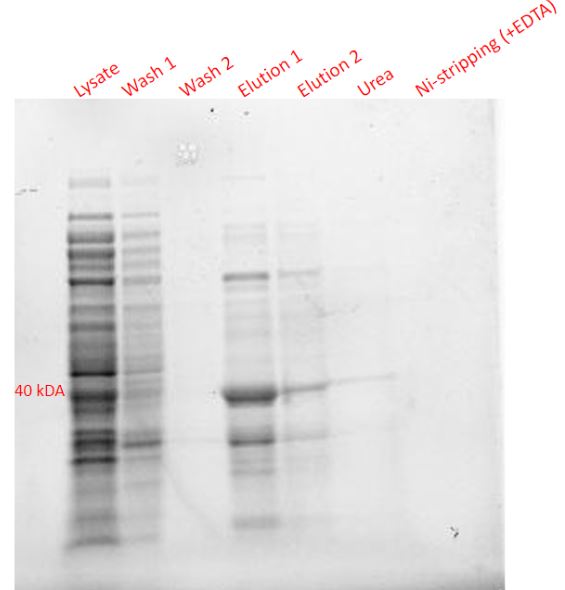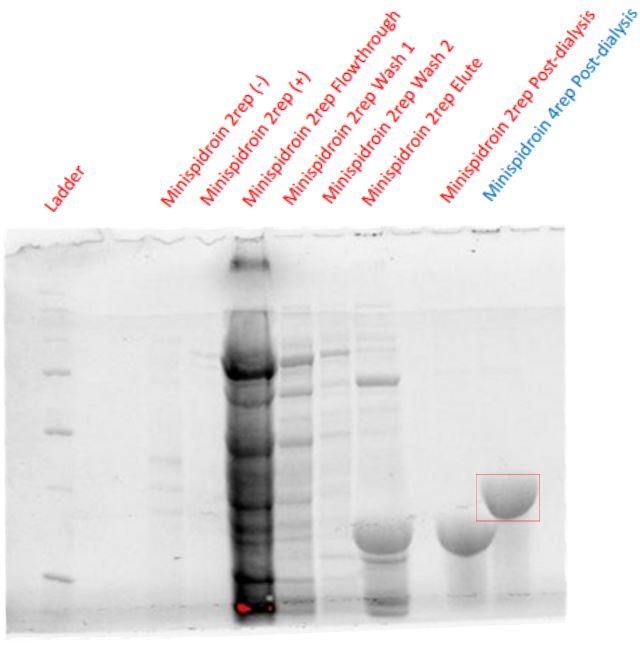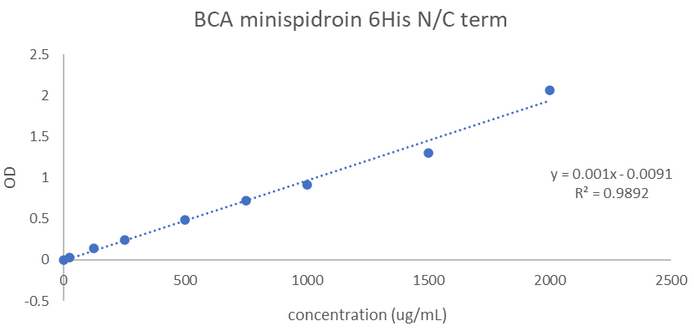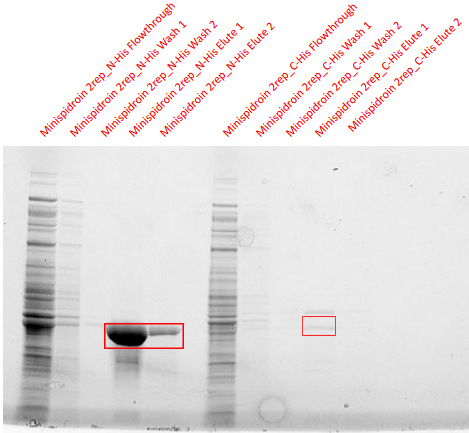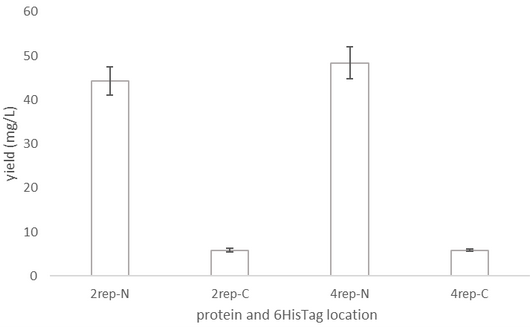Part:BBa_K4247012
Contents
- 1 Minispidroin_NT-4rep-CT_N-6His
- 2 Usage and Biology
- 3 Characterization
- 3.1 Optimization of inducer concentration
- 3.2 Optimization of lysis buffer
- 3.3 Heat purification
- 3.4 pH purification
- 3.5 Protein purification by IMAC
- 3.6 Stripping the Ni-NTA columns with urea
- 3.7 Protein yields
- 3.8 Comparison of protein production with respect to His-tag location
- 3.9 Simulating the assembly mechanism silk fiber networks
Minispidroin_NT-4rep-CT_N-6His
This part codes for the full minispidroin protein, a highly soluble spider silk protein, with a 6x His-tag in the N-terminus. This is a composite part consisting of the following basic parts: BBa_K4247005, 2 repeats of BBa_K4247001 and BBa_K4247002. BBa_K4247012 contains the coding sequence for the full minispidroin protein with 4 repeats of the central repetitive domain and a 6His-tag in the N-terminus of the protein.
This part is one of a collection of compatible minispidroin parts: BBa_K4247000 (Minispidroin_NT), BBa_K4247001 (Minispidroin_2rep), BBa_K4247002 (Minispidroin_CT), BBa_K4247004 (Minispidroin_NT-2rep-CT), BBa_K4247005 (Minispidroin_NT_N-6His), BBa_K4247007 (Minispidroin_NT-2rep-CT_N-6His), BBa_K4247010 (Minispidroin_NT-2rep-CT-SnoopTag_N-6His), BBa_K4247011 (Minispidroin_NT-4rep-CT), BBa_K4247012 (Minispidroin_NT-4rep-CT_N-6His), BBa_K4247013 (Minispidroin_NT-4rep-CT-SnoopTag_N-6His).
Usage and Biology
Dragline silk produced by spiders is one of the strongest natural materials to exist and it is mainly made up of structural proteins called spidroins. These spidroins consist of non-repetitive N-terminal and C-terminal domains and a repetitive central part consisting of tandem repeats of a certain amino acid sequence. These sequences are rich in alanine and glycine to form the crystalline and amorphous parts of the fibre respectively.
There are many research articles whose authors could successfully produce recombinant spider silk proteins and spin them into fibres by mimicking the conditions of the spider’s silk gland where the fibers are formed naturally. But a major drawback in many of these recombinant spidroins was their low solubility. It has been found that the N-terminus of the spidroin is highly soluble at neutral pH which contributes to the solubility of the protein.
In the spider's silk gland, before spinning, the spidroins remain in a highly concentrated and soluble state. Then, this highly concentrated spidroin solution called spinning dope is subject to a gradual drop in pH from 7.6 to 5.7 along the gland which triggers the formation of the fiber. This drop in pH triggers the N-terminus to be more stable and form large network-like structures whereas the C-terminus becomes more unstable to drive spontaneous fibre formation by forming the beta-sheet fibrils which form the core of the fiber. The N-terminal domain restricts the formation of silk fibers to a precise point in the silk duct, preventing silk proteins stored in the silk gland from agglutinating.
This clearly shows us that the solubility and pH sensitivity have a huge effect on the N- and C-terminus of the spidroin which thus affects the formation of fibers. It has been found that the N-terminus of MaSp1 (Major ampullate spidroin 1) from Euprosthenops australis, shows extremely high solubility and pH sensitivity whereas the C-terminus has low solubility and is inert to pH changes and vice versa for the MiSp (Minor ampullate spidroin) of Araneus ventricosus.
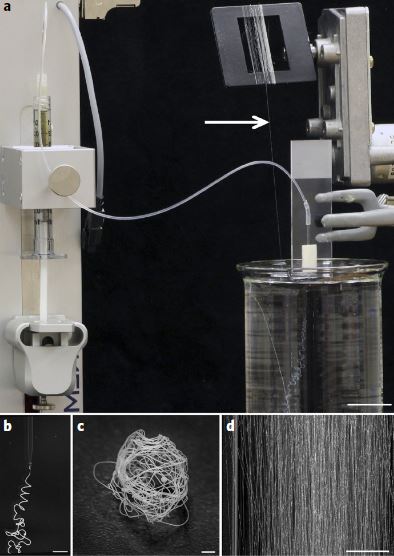 Andersson et al., 2017 show how minispidroin can be spun into long fibers
Andersson et al., 2017 show how minispidroin can be spun into long fibers
Herein, part BBa_K4247012 is a composite part formed from the following basic parts: No part name specified with partinfo tag. (Minispidroin_2rep) and BBa_K4247002 (Minispidroin_CT). BBa_K4247012 contains the coding sequence for the full minispidroin protein with 4 repeats of the central repetitive domain and a 6x His-tag in the N-terminus.
Characterization
Optimization of inducer concentration
Aim - To determine the concentration of inducer required for optimal protein expression, the weight of the desired protein is 40.3 KDa.
Results - Cell cultures were grown ON at 37°C. Then, the next day, the cultures were diluted to an OD600 of 0.1 and induced with 0.1, 0.3, 0.5 and 1mM IPTG and grew ON. We can clearly see that around 40kDa, there is a darker band in the induced lanes compared to the uninduced lane, showing that the protein is expressed upon induction with IPTG. Further, among the induced lanes, protein expression seems to be best in the range of 0.1-0.5 mM, but a western blot is needed for any clear conclusion.
A western blot was done on the above SDS-gel to confirm that the proteins we see are indeed the minispidroin proteins. Since the proteins were expressed with a 6x His-tag, we used mouse anti-hexa his primary antibodies and goat anti-mouse HRP-conjugated secondary antibodies for the western blot.
Conclusion - As observed in the western blot, IPTG concentration does not seem to impact particularly the expression of the protein. Considering that the shorter version of this minispidroin is expressed better at 0.3 mM, we decided to stick to this concentration for protein expression. This result aligns with the minispidroin literature since the authors found 0.3 mM IPTG to the optimal concentration but it also shows that IPTG concentration may not particularly impact protein expression of this protein.
Optimization of lysis buffer
Aim - To determine the best buffer for cell lysis that provides the protein in a soluble state.
Results - In order to lyse our cells by sonication, we used 2 different lysis buffers and then decided which lysis buffer gave the most proteins in the soluble fraction. The recipes of the buffers are as follows, Buffer 1: 50 mM NaH2PO4 + 500 mM sodium chloride + 10 mM imidazole + 0.5% Triton X-100 + 10% glycerol + 2 mM DTT (added right before use), pH 8.0 Buffer 2: 20mM Tris-Cl, pH 8.0
The cell cultures were centrifuged to obtain the cell pellets which were resuspended in the cell lysis buffer and then sonicated until a clear lysate was obtained. The lysate was centrifuged to obtain the insoluble and soluble fractions in the pellet and supernatant respectively. In the SDS-gel, minispidroin_NT-4rep_CT is visible in the buffer 2 supernatant.
Further, a western blot was done on the above SDS-gel to confirm that the proteins are indeed the minispidroin_NT-4rep-CT by using the above mentioned antibodies. Minispidroin_NT-4rep_CT is better obtained with buffer 2 since by using buffer 1 it seems to accumulate more in the pellet and would thus require a more difficult purification.
Conclusion - From the SDS-gel and western blot, we can conclude that buffer 2 is better than buffer 1 since it provides more protein in the soluble fraction. This confirms the results of the minispidroin literature since the authors used buffer 2.
Heat purification
Aim - To determine if there is a temperature that would precipitate only the minispidroin proteins without the other E.coli proteins, to facilitate an easy purification method using heat treatment.
Results - To test if higher temperatures would yield pure proteins or help separate minispidroin_Nt-4rep_CT from the native E. coli proteins, the lysate was subject to 70 and 80°C heat treatment for 20 minutes. It is clear that most of the protein precipitates at 70 and 80°C but it is not very pure since a lot of other proteins are also precipitating. We performed a western blot to confirm the finding. However, we decided to try lowering the heat treatment temperatures and check at what temperature the protein does precipitate. A note is that also in the controls, a low level of expression leads to the production of minimal amounts of the protein.
The soluble fraction of the lysate was subject to different temperatures (37, 40, 45, 50, 60°C) for 20 minutes. Then, after heat treatment, the samples were centrifuged and the supernatants and pellets obtained after different temperatures were run on an SDS-gel. It seems that minispidroin-NT_4rep_CT remains soluble up to 50°C. Again, a lot of other proteins also precipitate at those temperatures, so it is not possible to obtain the pure protein just by heat treatment.
Conclusion - So, although most of the protein precipitates at temperatures above 50°C, heat treatment is not a suitable method for protein purification since there is no temperature that precipitates minispidroin without also precipitating other proteins.
pH purification
Aim - To determine if there is a certain pH at which minispidroin_NT-4rep-CT precipitates without the other E.coli proteins, to facilitate an easy purification method using changes in pH.
Results - The soluble fraction of the lysate was adjusted to different pH (5.5, 6, 6.5, 7, 7.5) and incubated for 1h at room temperature. Then, the samples were centrifuged and the supernatants and pellets obtained at different pH values were run on an SDS-gel. It is clear that minispidroin_NT-4rep-CT does not precipitate at any pH since the lanes with pellets do not have any bands around 40kDa.
Conclusion - Since there is no pH value at which the protein precipitates, the method of adjusting the pH cannot be used for purification.
Protein purification by IMAC
Aim - To purify the protein by IMAC (immobilized metal ion chromatography) using Ni-NTA resin in a quicker way.
Results - Ni-NTA resin was added to the soluble fraction of the lysate and allowed to incubate for 1h under shaking conditions. Then, it was centrifuged to collect the resin with the proteins and the supernatant was collected as flowthrough. Then, the resin was washed twice and eluted 5 times.
Lysis buffer - 20mM Tris-Cl, pH 8.0
Wash buffer - 20mM Tris-Cl, 5mM Imidazole, pH 8.0
Elution buffer - 20mM Tris-Cl, 200mM Imidazole, pH 8.0
Dialysis buffer - 20mM Tris-Cl, pH 8.0
Conclusion - It can be seen that most of the protein is collected in the first elution without much of it being lost in the flowthrough or the washes.
Stripping the Ni-NTA columns with urea
Aim - To wash the Ni-NTA columns with urea and strip them with EDTA after elution to determine if there was some aggregated protein in the resin or if there were any other metal binding proteins stuck to the column.
Results - After washes and elution, the column was washed with 8M urea. Any aggregated protein that is clumping the column would be solubilized in the urea and hence removed from the column. Then, the column was stripped using EDTA since EDTA can chelate metal ions and hence remove all the Ni plus anything bound to, for example metal binding proteins. From the experiment it seems we did not lose protein in aggregates (urea lane) nor stuck to the Ni (EDTA). We can see that while some of the protein is lost in the first wash, most of it is in the first elution. Further, a small amount of protein is also seen in the second elution and the urea wash and an even smaller amount after stripping the columns.
Conclusion - Although a small amount of protein is lost in the wash or stuck to the column, most of the protein is obtained in the first elution. Moreover, dialysis worked as it can be seen in the following picture.
Protein yields
Aim - To do a BCA assay after dialysis of the protein to quantify the final yield.
Results -
Minispidroin_NT-4rep-CT_N-6His was inoculated in LB, grown at 37°C, induced with 0.3mM IPTG and allowed to express the protein ON in a flask. The cells were lysed, the proteins purified by IMAC and dialysed ON. Then, a BCA assay was done to estimate the protein yields.
Conclusion - The yield of Minispidroin_NT-4rep-CT_N-6His was found to be 48.39 mg/L of culture.
Comparison of protein production with respect to His-tag location
Aim - To compare the protein production of the Minispidroin_NT-4rep_CT when the 6x His-tag was at the N-terminus or the C-terminus.
Results - Cells expressing minispidroin proteins with a His-tag in the N-terminus or C-terminus were grown to an OD600 of 0.1 and induced with 0.3mM IPTG to induce protein expression. Then, the cells were grown at 28°C post-induction ON. Then, the cells were lysed and the proteins were purified by IMAC. Further, the different purification fractions were run on an SDS-gel to compare the amount of proteins eluted.
Further, a BCA assay was done on the purified proteins to quantify the yields.
Conclusion - It is very evident that switching the His-tag from the C-terminus to N-terminus increased the protein production of the Minispidroin protein substantially, by nearly 8 times.
Simulating the assembly mechanism silk fiber networks
We simulated the formation of a spider silk fiber network during spinning and stretching of the silk fiber using dissipative particle dynamics. This was done on a different number of the characteristic hydrophobic alanine-repeat motif. The data from these simulations was then analysed by identifying clusters of the hydrophobic parts of the repeats and generalising them into nodes (red dots), and links between nodes was then indicated in bridges (black lines), where their thickness indicates the number of connections.
The simulation results indicate that spider silk proteins with 3 and 4 repeats seem to form the most stable fiber networks with large average beta sheet crystals and many connecting bridges, although our simulations were limited because we did not get a chance to simulate proteins with a larger number of repeats than 6.
Fig: Graph depicting the development of average beta-sheet crystals size and number of bridges for networks of spider silk proteins with different number of repeats. The average beta-sheet crystals size is measure in the number of hydrophibic beads that are included in beta-sheets, where each bead represent 3 hydrophobic amino acid residues.
Additionally we simulated spinning under the conditions of failed spinning attempts to try and troubleshoot and fix our mistakes for future attempts. We observed that the failed spinning case that we examined with a protein concentration of 15% had a lowered size of its average beta sheet crystals as well as a low connectivity. Through an additional simulation, with raised shear rate, which represents a higher shear force in spinning, accomplished by a narrower needle, it was observed that a raised shear rate could counteract the lowered average size of beta sheet crystals, but not the network connectivity.
Fig: Graph depicting the development of average beta-sheet crystals size and number of bridges for networks of spider silk proteins with different number of repeats, at different concentrations of spinning, and with different shear rates, which indicate how much shear force is applied to the proteins during spinning (lack of specific shear rate indicates a shear rate of 0.1). The average beta-sheet crystals size is measure in the number of hydrophibic beads that are included in beta-sheets, where each bead represent 3 hydrophobic amino acid residues.
| None |

